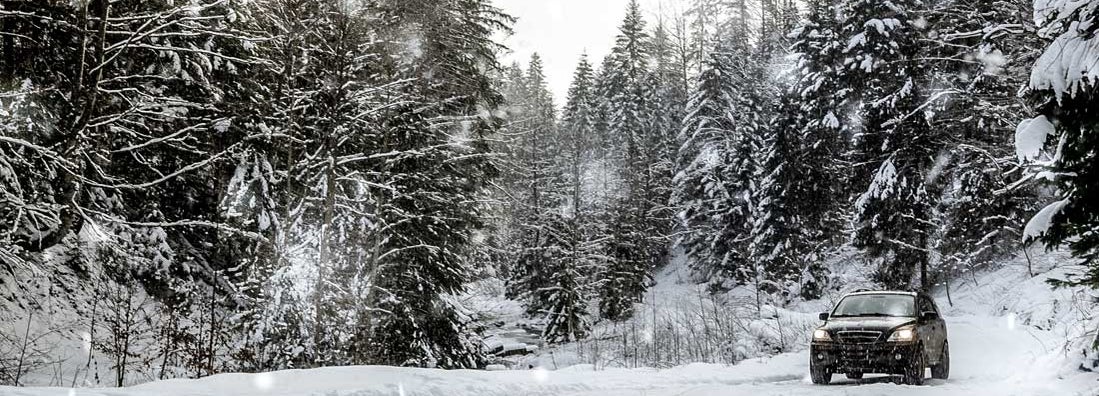What’s the Best Way to Drive in Snow?

Driving in snow and adverse winter weather can be frightening for many people especially if you’ve never experienced it before. According to the AAA Foundation for Traffic Safety, driving conditions caused by winter weather are a factor in nearly half a million crashes and more than 2,000 road deaths every year.
Winter weather can cause roadways to be hazardous due to snow and ice, which means you need to prepare yourself and your vehicle for safety. If you must travel in the winter during potentially adverse conditions, there are a number of things you can do to make it as safe as possible.
Driving in Snow for Beginners
If you’re new to driving in snow, don’t fret! Just take it nice and slow and ideally you can avoid busy highways until you get used to it a little more. Here are some extra tips for snow newbies:
- Don’t underestimate even a little snow. Many people will worry about driving in a foot of snow, but that’s not all you need to worry about. A thin layer of snow can easily melt and refreeze, creating dangerous, icy conditions.
- Don’t panic. If you hit a slick, icy spot, don’t slam on your brakes. Turn your wheel into the spin to straighten your vehicle and take your foot off the gas until you regain control.
- If you’re stuck, don’t try to accelerate your way out. If you do get stuck, don’t attempt to free your vehicle by accelerating too much because you will probably get even more stuck or you might lose control of your vehicle.
- Clean the snow off the top of your car. If you have snow on top of your vehicle and have to suddenly brake or turn while driving, the snow could fall onto your windshield and block your vision for a split second — long enough to cause an accident.
Extra Tips for Driving in the Snow
Here are a few more helpful winter safe driving tips direct from the experts at the AAA:
- Stay home. Only go out if necessary. Even if you can drive in bad weather, it’s better to avoid taking unnecessary risks by venturing out unless you need to.
- Drive slowly. Always drive at a slower speed to account for slippery conditions and lower traction when driving on snow or ice.
- Accelerate and decelerate slowly. Apply the gas slowly to regain traction and avoid skids. Try not to be in a hurry and give yourself plenty of time to come to a complete stop. Remember, it takes longer to slow down on snowy or icy roads.
- Increase your following distance to at least five or six seconds. Slowing down on the snow takes longer, so be sure to give yourself and any vehicle ahead of you extra space. If the car ahead of you needs to stop quickly, you could slide off the road if you have to brake too quickly.
- Know your brakes. Threshold braking is the best way to stop, regardless of the type of brakes on your vehicle. Keep the heel of your foot on the floor and use the ball of your foot to apply firm, steady pressure on the brake pedal. If a wheel locks, release the brake and reapply.
- Don’t stop on hills. Your car won’t be able to start again if you come to a stop on a hill in snowy conditions, so be sure to always keep the car going on any hills.
- Don’t power up hills. Try to get a little extra momentum before reaching a hill, and let that slight increase in speed carry you to the top. Reduce your speed at the top of the hill so that you don’t lose control on the way down.
- Keep rolling. Don’t stop if you can avoid it. If you can slow down enough to keep rolling until a traffic light changes, do it.
What Gear Is Best for Driving in Snow?
Most modern vehicles are automatic drive, so you won’t need to adjust anything other than your speed. It’s best to not drive too fast, and definitely don’t accelerate or break very hard or fast.
If you do have a manual vehicle, you’ll probably want to keep your vehicle in 1st, 2nd, or 3rd gear on ice or snow, depending what type of road you’re driving on. A slower, lower gear gives the tires more power and more traction, which is absolutely necessary on snowy or icy roads.
A lower gear also powers your vehicle more slowly, which is always recommended when driving conditions or less than ideal. When turning, always remember to shift into a lower gear when there’s ice or snow on the road.
How to Prepare for Driving in Snow

Properly preparing your vehicle for traveling in winter weather can keep you safe. From the tires to the battery, knowing what to check before you head out is essential to preparing for your trip out in adverse weather.
- Check your tire tread. Good tire tread depth is 6/32 or deeper. If your depth is 4/32 or less, you should think about replacing your tires. If your depth is 2/32, you need new tires as soon as possible.
- Fill up your tires. Check your tire pressure. Most passenger vehicles will recommend a tire pressure of 32 to 35 psi. This information is commonly on a sticker on the inside of the driver’s door and in the manual. Extreme temperatures can cause tire pressure to fluctuate.
- Consider snow tires. Snow tires are most commonly used during the winter months, from late November to early April.
- Change your oil and antifreeze. Make sure your fluids are at the proper level. Cold temperatures cause the fluids to thicken, so start your car several minutes prior to leaving in below-freezing temperatures.
- Fix your heater. If you know that your heater needs to be serviced, have it done prior to winter so you don’t get caught stranded without heat.
- Inspect your battery. Below-freezing temperatures cause the battery to lose starting capacity, making it work harder to start your vehicle. Have your battery capacity checked by a mechanic.
Can Driving in Snow Damage Your Car?
The salt from snow can damage your car by causing rust and corrosion. Salt can stick to the metal components of the vehicle and cause corrosion if it's left there. This is especially true of the undercarriage, brakes, and wheel wells.
Washing your vehicle frequently during the winter months can help to eliminate the salt. Be sure to wash the undercarriage once a month and don’t use a cloth to wipe off the salt, because this could scratch the paint.
Condensation can accumulate and turn to ice around the power steering, brake, and engine transmission systems. This ice could cause potentially hazardous leaks in these systems.
Driving with too much or too little tire pressure can lead to uneven wear and shorten the life of your tires. It could even lead to a potentially dangerous blowout on the road.
If you can, just stay home and enjoy watching the snow from the safety of indoors. And remember, even if you are an expert in snow driving, other drivers may not be, so strong caution is always advised when there’s snow on the road.
If your car is damaged in the snow, you’ll want to have the right type of car insurance coverage in place so that you'll only have your deductible to worry about if you have a claim. It’s also a good time to add roadside assistance to your policy in case your car has problems out in the middle of the road.
So before the next snowfall comes, whether it’s just a few snowflakes or a full-on blizzard, be sure to discuss your auto insurance with a local independent insurance agent.
http://exchange.aaa.com/safety/roadway-safety/winter-driving-tips/
http://exchange.aaa.com/wp-content/uploads/2012/09/How-To-Go-On-Ice-and-Snow.pdf
http://www.ops.fhwa.dot.gov/weather/weather_events/snow_ice.htm http://www.drivingfast.net/track/threshold-braking.htm#.UM5NAXfWbyY
